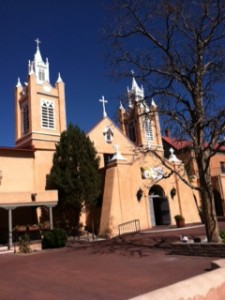Strolling down Old Town Albuquerque’s cobbled streets lined with brightly colored adobe structures, I sense the area’s ancient, rich history. Haunting melodies from a Native American flute drifts among the ancient buildings. To the east, the Sandia Mountains sprawl in their majestic beauty.
The Albuquerque area has been inhabited for hundreds of years, first by Native Americans, then beginning in 1598, the area was conquered and reconquered. Finally, in 1706 Francisco Cuervo y Valdes founded a villa first named San Francisco Xavier de Albuquerque. It was later renamed and finally called the name recognized today, Albuquerque.
The settlement consisted mostly of farms strung out along the Rio Grande. Apache and Comanche raiding made it necessary to create a defensible populations center, so a villa, or plaza, was formed.
The Sante Fe Trail between Missouri and Mexico opened in 1821, after Mexico won her independence from Spain. Albuquerque became an important stop and freighting center along the way. In 1850 New Mexico became an American Territory.
Between 1867 and 1878, Albuquerque was a quiet community with a population of less than 2,000 people. A few businesses served local farmers and sheep herders. With the promise of a railroad coming to Albuquerque, businesses and immigrants flocked to the area.
Then came the discouraging news that the railroad would be routed about a mile and a half to the east of the plaza. Starting in 1880, a “New Albuquerque” began to spring up by the tracks and many of the Old Town business relocated.
In 1912 New Mexico became the 47th state.
In the 1930’s and ‘40’s, Old Town was rediscovered by artists and merchants. In the 1950’s, many buildings were restored in the Spanish/Pueblo Revival Style. Today a stroll through Old Town reveals a delightful mix of businesses and residences in Spanish Colonial, nineteenth-century and modern styles, representing Old Town’s long and varied history.
Winding down colorful brick paths, visitors discover The Rectory, San Felipe De Neri Church, Sister Blandina Convent, Our Lady of the Angels School and many other historical sites. Several of the structures, mostly built of adobe, are still used today, though not necessarily for their original purpose.
Of particular interest is The Albuquerque Museum in Old Town. The large facility is dedicated to preserving the art of the Southwest as well as 400 years of Albuquerque history as shown in exhibits and artifacts of colonial life in New Mexico. Delightful sculpture gardens grace the Museum grounds. Both indoor and outside tour guides share fascinating tidbits of Albuquerque history.
If you travel to Albuquerque, be sure to take in Old Town. Step along ancient streets, do a little shopping and treat yourself to a traditional southwest dining experience. Old Town Albuquerque has a unique flavor shaped by centuries-old cultures.



You’ve made me want to go there. Perhaps a road trip is in order before long.
You did a great job of describing the beautiful city where WWW hosted their latest conference. I was too busy to take the tour this time, but I feel as if I was there through your great descriptive writing!
Another fabulous post by the gifted Mary Trimble. I was in this city only once and for only a brief time. If I ever have a chance to go again, I’m bringing this post as my guide!
I too have loved visiting Albuquerque during the two WWW conferences we’ve had there. It’s one of my favorites! Thanks for writing about it so well and sharing its charm and history.